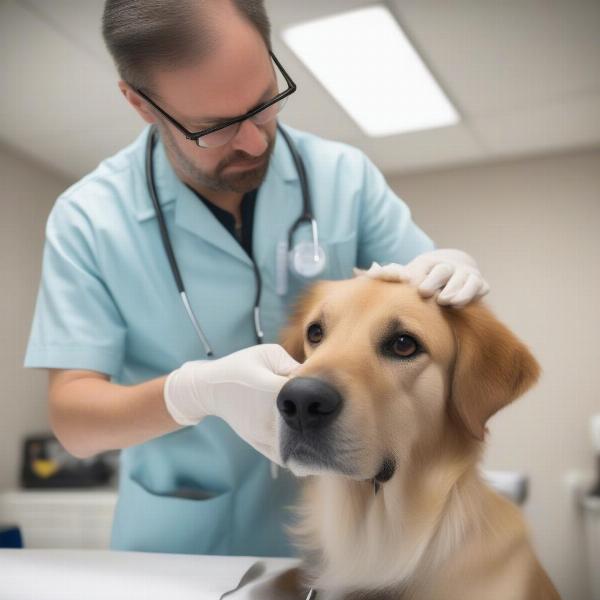Dog facial droop can be a worrying sign for any owner. It can range from a subtle asymmetry to a complete inability to move the muscles on one side of the face. This article will explore the various causes of facial droop in dogs, from relatively benign conditions to more serious illnesses, and discuss the diagnostic process and treatment options available.
Facial droop, also known as facial paralysis, occurs when the nerves that control the facial muscles are damaged or dysfunctional. This can affect a dog’s ability to blink, close its eyes, move its lips, and even eat or drink normally. Recognizing the signs early is crucial for effective management and a better prognosis. While some causes are relatively minor and resolve on their own, others require prompt veterinary intervention.
Common Causes of Facial Droop in Dogs
Facial droop in dogs can be attributed to a variety of causes. Some of the most common include:
- Idiopathic Facial Paralysis: This is the most frequent cause and is often referred to as Bell’s Palsy in dogs. The exact cause is unknown, but it’s thought to be an inflammatory condition affecting the facial nerve. facial paralysis in dogs often resolves spontaneously within a few weeks to months.
- Ear Infections: Infections in the middle or inner ear can put pressure on the facial nerve, leading to paralysis. These infections can be bacterial, fungal, or parasitic.
- Trauma: Injury to the head or face can directly damage the facial nerve. This can result from accidents, bites, or even improper grooming practices.
- Tumors: Growths, both benign and malignant, can press on or infiltrate the facial nerve, causing dysfunction. A trigeminal nerve sheath tumor dog life expectancy can vary depending on the tumor’s location and aggressiveness.
- Hypothyroidism: While less common, an underactive thyroid can sometimes be associated with facial nerve paralysis.
 Veterinarian examining a dog with facial droop
Veterinarian examining a dog with facial droop
Diagnosing Dog Facial Droop
If you notice any signs of facial droop in your dog, it’s essential to consult a veterinarian immediately. The veterinarian will perform a thorough physical examination, including a neurological assessment, to determine the extent of the paralysis and identify any underlying causes. Diagnostic tests may include:
- Blood tests: To rule out underlying metabolic conditions like hypothyroidism or to check for signs of infection.
- Ear cytology and culture: To identify any infections in the ear.
- Imaging (X-rays, CT, or MRI): To visualize the skull and identify any tumors or fractures.
Treatment Options for Facial Droop
Treatment for facial droop depends on the underlying cause. For idiopathic facial paralysis, supportive care is usually sufficient. This may include:
- Eye lubrication: To prevent dryness and corneal ulcers since the dog may be unable to blink fully.
- Hand-feeding: If the dog is having difficulty eating.
- Medications: Pain relievers or anti-inflammatory drugs may be prescribed.
In cases of ear infections, antibiotics or antifungals will be necessary. If a tumor is identified, surgery, radiation therapy, or chemotherapy may be recommended.
What are the first signs of facial droop in a dog?
A noticeable asymmetry in the face, often with one ear or eyelid drooping lower than the other, is typically the first sign. The dog might also drool excessively or have difficulty eating.
Can facial droop in dogs be cured?
The prognosis depends on the underlying cause. Idiopathic facial paralysis often resolves spontaneously. Other causes, like infections or tumors, require specific treatment and the outcome can vary.
Conclusion
Dog facial droop can be alarming, but it’s important to remain calm and seek veterinary attention promptly. dog facial paralysis can stem from various causes, each requiring a different approach to treatment. Early diagnosis and appropriate intervention significantly improve the chances of a full recovery. While observing your dog for any unusual signs, remember that conditions like a facial palsy dog can often be effectively managed with proper care. If you notice your dog acting drunk, it could indicate a serious neurological issue and requires immediate veterinary attention.
ILM Dog is a leading international online resource for dog care and upbringing. We offer expert advice on various aspects of dog ownership, from breed selection to senior dog care. Our articles are written by experienced professionals and cover everything from health and nutrition to training and behavior. Whether you’re a new dog owner or a seasoned expert, ILM Dog has the information you need to provide the best possible care for your canine companion. Contact us at [email protected] or +44 20-3965-8624 for any inquiries. We’re dedicated to helping you and your dog live a happy, healthy life together. Visit us at ILM Dog for more information.